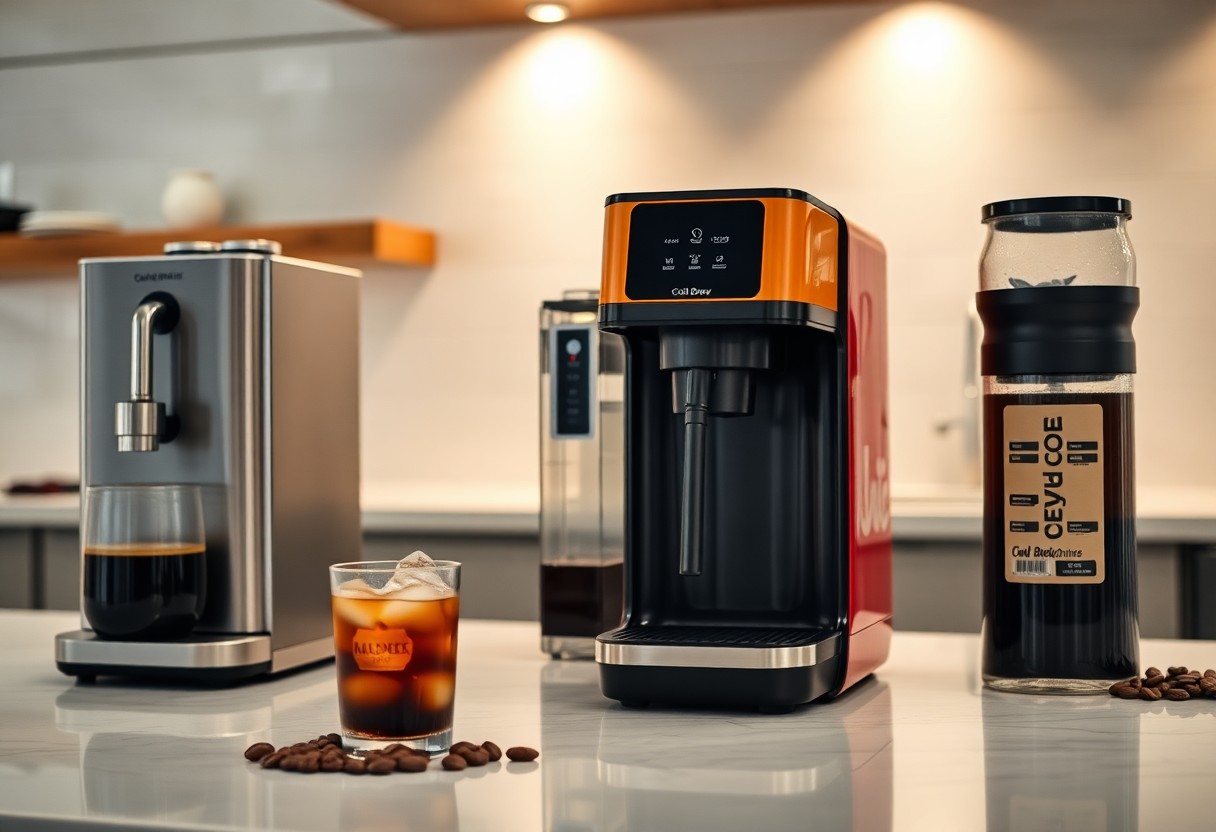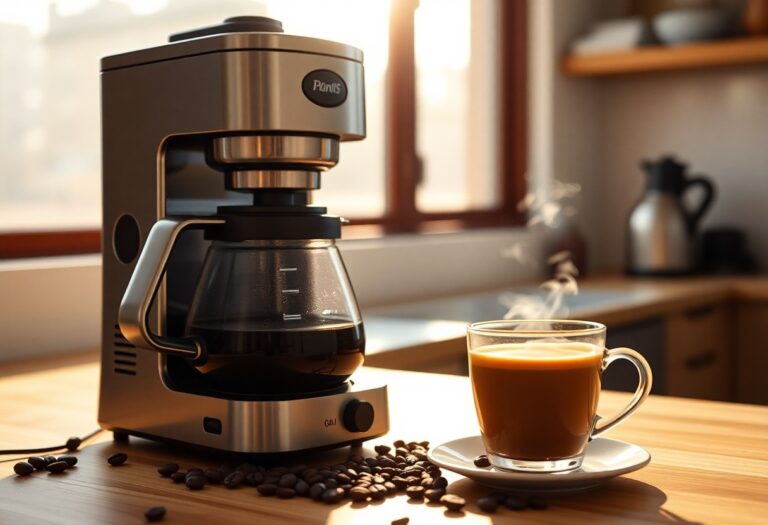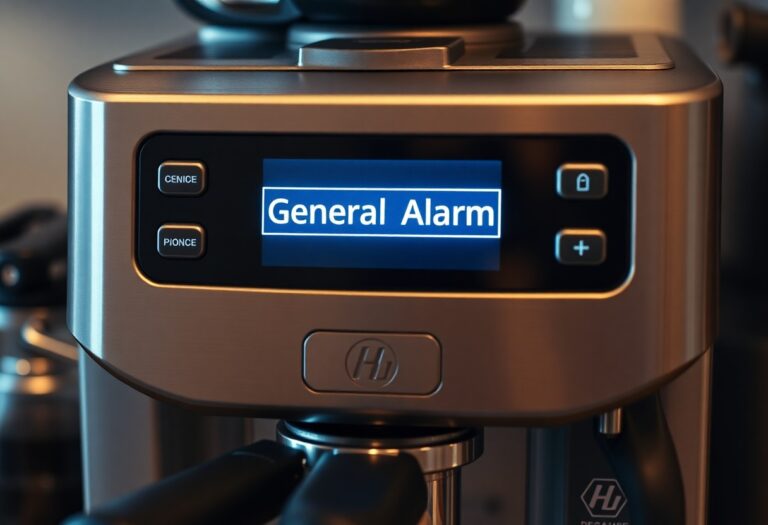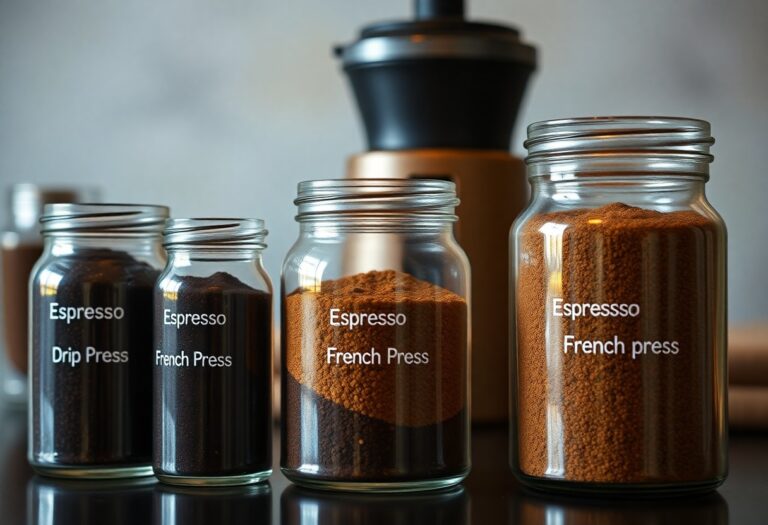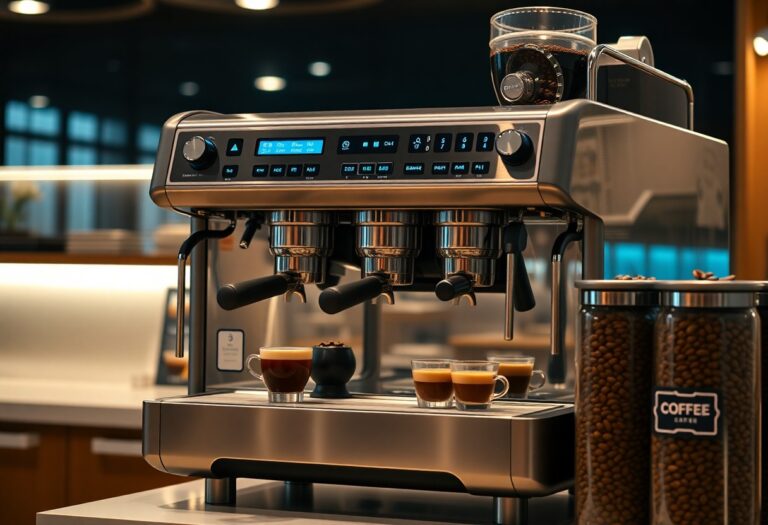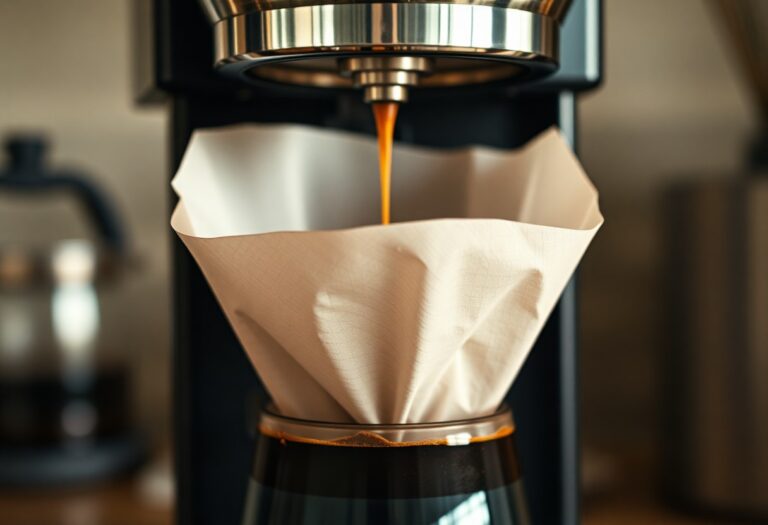What Machine Makes Iced Coffee – Cold Brewing Equipment
With a myriad of options available, finding the right equipment for cold brewing iced coffee can elevate your drink experience. Investing in a reliable cold brew machine not only guarantees a refreshing, smooth flavor but also simplifies the brewing process, allowing you to enjoy your coffee whenever you desire. Using the right machine can help you avoid bitterness while extracting the most aromatic flavor from your coffee grounds. Check out this Cold brew machine – best price to kickstart your journey into the world of cold coffee brewing.
Key Takeaways:
- Cold brewing equipment typically includes a coffee maker designed to steep coarse coffee grounds in cold water for an extended period, usually 12 to 24 hours.
- Key components of cold brewing equipment include a brew chamber, a filter system, and a carafe or pitcher for storage.
- Different designs, such as immersion brewers and drip systems, offer various brewing methods and flavor profiles for iced coffee enthusiasts.
- Some cold brewing setups are specifically designed for commercial use, providing larger capacities and ease of use for high-volume coffee production.
- When dicking out cold brewing equipment, consider factors like brewing capacity, ease of cleanup, material quality, and any additional features that enhance the brewing process.
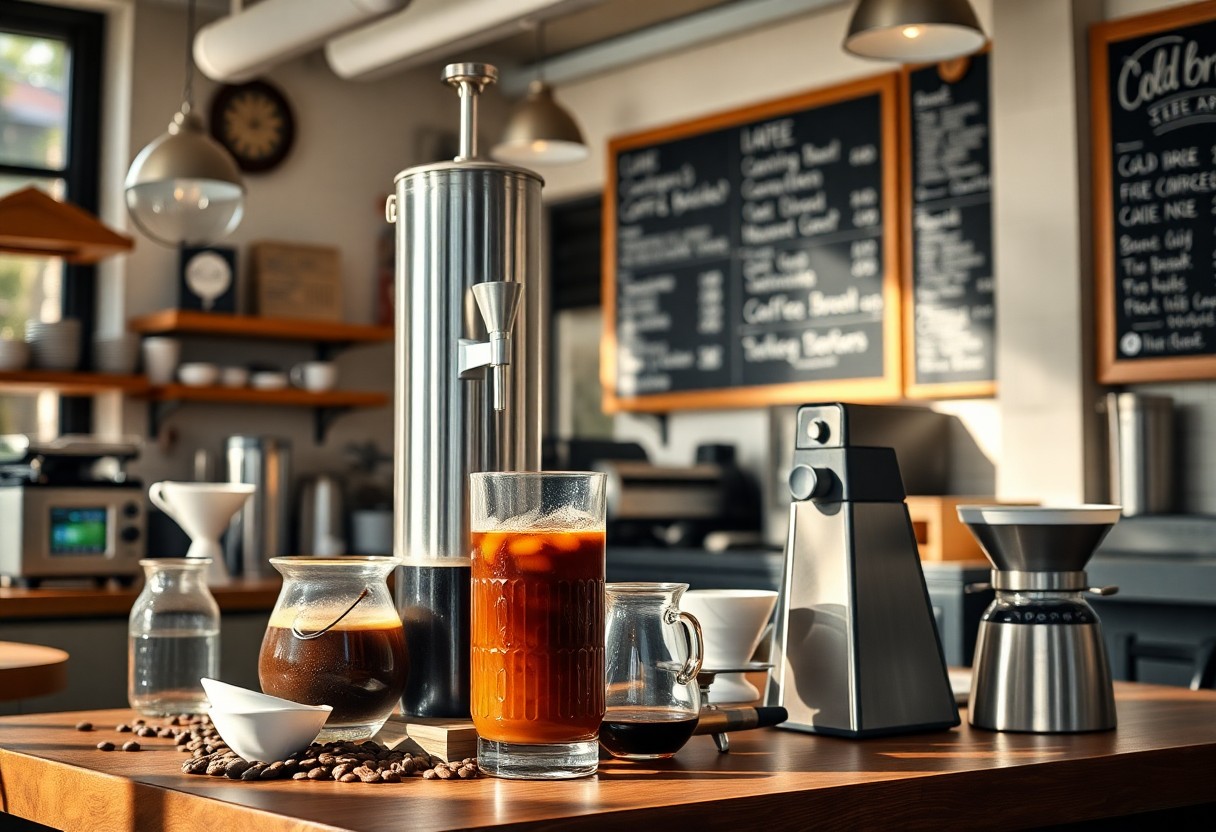
The Mechanics of Cold Brewing: Gear that Makes it Happen
The right equipment transforms cold brewing into a delightful experience, combining science and art to create your perfect iced coffee. You have options ranging from simple manual brewers to sophisticated machines that automate the process. Each piece of gear contributes uniquely to the outcome, ensuring that you can capture the full flavor potential of your coffee beans while maintaining a smooth, low-acidity profile.
Essential Components of Cold Brew Systems
A complete cold brew setup typically includes a brewing vessel, a filtration system, and a method for holding and serving the final product. The brewing vessel, made from glass or stainless steel, allows you to steep coffee grounds in cold water effectively. Filters made from nylon or metal keep those grounds at bay, while a serving pitcher ensures your delicious brew is easy to pour and enjoy.
Variations in Brewing Mechanisms
Diverse brewing mechanisms are available, each providing a distinct method for achieving cold brew. You might encounter immersion brewers, which steep grounds directly in water, or drip brewers that slowly filter water over coffee grounds. Systems can also vary in size, allowing for batches ranging from single servings to large quantities suitable for gatherings.
For instance, immersion brewers, like the popular French press format, allow you to steep coffee grounds in cold water for an extended period, usually 12 to 24 hours, resulting in rich and complex flavors. Conversely, drip systems, such as those used in the Japanese iced coffee method, offer a more controlled, precision brewing experience where water is dripped over coffee grounds in a slow, steady manner. This can produce a more concentrated flavor with brighter acidity. Each method caters to different preferences, giving you flexibility in your cold brewing adventures.
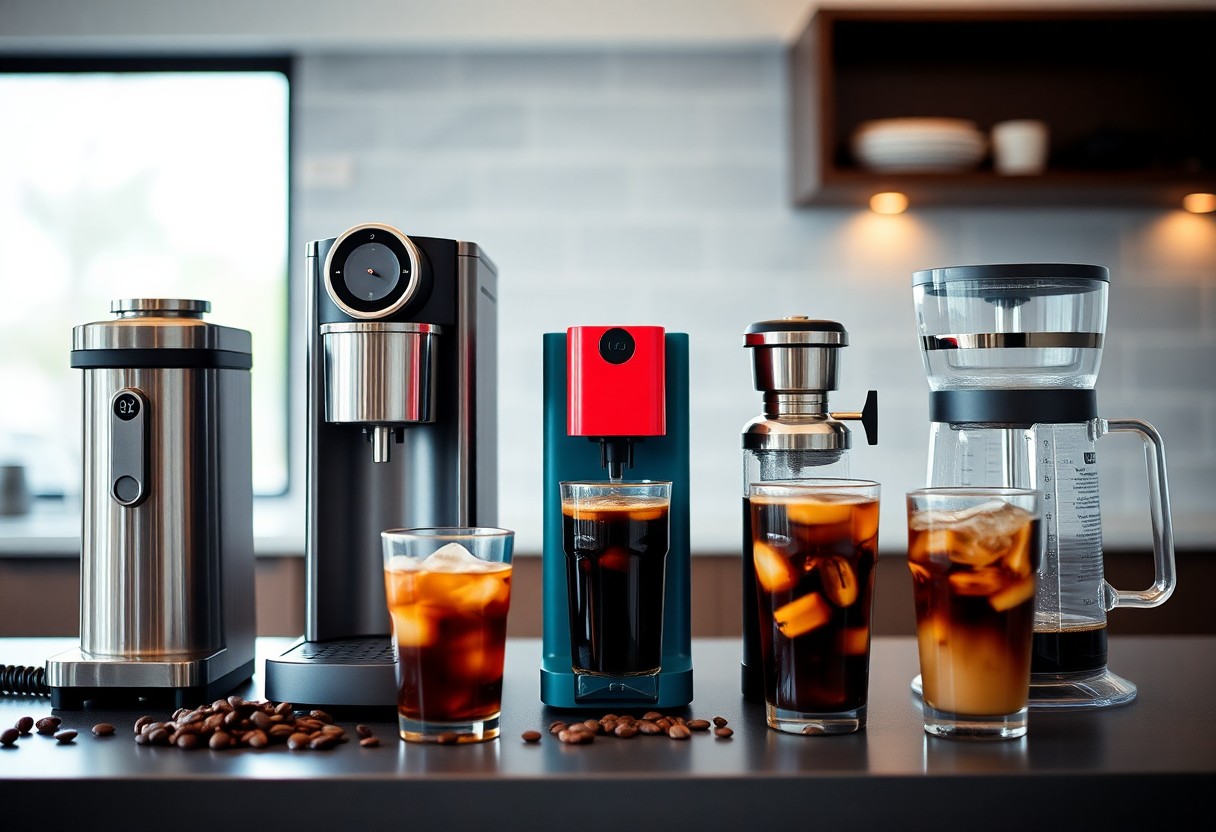
Comparing Commercial Cold Brew Machines: Which One Suits You?
| Machine Type | Best For |
|---|---|
| High-Volume Brewers | Cafés, restaurants, and events |
| Compact Options | Home enthusiasts and small kitchens |
High-Volume Brewers for Cafés and Restaurants
For those in the business of serving iced coffee to large crowds, high-volume brewers stand out as efficient and effective. Machines like the FoodService Direct Moka Express can brew up to 3 gallons at a time, allowing you to keep up with demand during peak hours. These systems typically feature advanced filtration and temperature control options to ensure flavor consistency, making them indispensable in fast-paced settings.
Compact Options for Home Enthusiasts
If you enjoy cold brew from the comfort of your home, compact machines like the Takeya Cold Brew Maker are ideal for small kitchens. These devices brew concentrated cold coffee in as little as 12 to 24 hours with a simple steeping process, requiring minimal counter space and cleanup. Perfect for personal use, they ensure you can indulge your iced coffee cravings without compromising on flavor or quality.
Compact options such as the Hario Mizudashi and AeroPress are not only space-saving but also affordable, making them accessible for any home barista. These devices allow you to experiment with different coffee types and brewing times to discover your perfect flavor profile. Their portability means you can easily store them away when not in use, keeping your kitchen tidy while still enjoying exceptional cold brew at your convenience.
The Role of Bean Selection in Cold Brew Quality
Choosing the right beans significantly impacts the flavor and quality of your cold brew. Cold brewing tends to emphasize low acidity and mellow flavors, so selecting beans with sweet, chocolatey, or fruity notes will yield the best results. Look for beans that are specifically labeled for cold brew or those that have a darker roast profile, as they tend to produce a smooth and rich beverage that shines when chilled.
How Grind Size Affects Extraction
Grinding your coffee beans to the correct size is vital for achieving the desired flavor profile in cold brew. A coarser grind increases extraction time, allowing for a smoother, less bitter end product. If the grind size is too fine, over-extraction can occur, leading to an unpleasant, astringent taste. Aim for a grit similar to sea salt for optimal cold brewing results.
The Best Coffee Beans for Cold Brewing
For the best cold brew experience, opt for beans known for their rich flavor and low acidity. Varietals such as Colombian, Guatemalan, and Brazilian beans are popular choices because they provide sweet and nutty characteristics, while also balancing the drink’s overall profile. Experimenting with single-origin beans can also lead to unique flavor discoveries that enhance your cold brew.
When dicking out beans specifically for cold brewing, consider those roasted within the past few weeks for optimal freshness, as coffee tends to lose flavor over time. Look for coffee with tasting notes like chocolate, caramel, or stone fruit, as these can create an enjoyable drinking experience. Additionally, you might explore blends designed for cold brew, which typically combine beans that complement each other’s flavors while maintaining a smooth finish. This attention to bean selection will play a significant role in elevating your cold brew game.
The Economic Implications of Cold Brew Equipment
Investing in cold brew equipment presents significant economic implications for your coffee business. As the demand for cold brew continues to rise, understanding the financial landscape around these machines is vital. Your choice can influence everything from upfront costs to potential profit margins, making it imperative to evaluate how this equipment fits into your overall strategy.
Investment Costs vs. Long-Term Returns
Initially, the investment costs for high-quality cold brew machines may seem steep, ranging from a few hundred to several thousand dollars. However, these upfront expenses are often offset by the long-term returns generated through increased sales and customer loyalty, particularly during warm months when iced coffee consumption peaks.
The Impact on Overall Coffee Sales
Cold brew equipment can significantly enhance your overall coffee sales. As consumer preferences shift towards cold beverages, introducing cold brew options allows you to capture a broader market demographic, including younger consumers and those seeking a smoother, less acidic coffee experience. Implementing a dedicated cold brew line can lead to an increase in average ticket size, where customers opt for premium cold brews over standard offerings.
In addition, adding cold brew to your menu creates opportunities for creative marketing initiatives, seasonal specials, and even collaborations with local businesses. As word spreads, loyal customers may engage with your brand on social media, boosting visibility. The potential for upsells such as flavored cold brews or hybrid beverages further amplifies your revenue streams, proving that the right cold brew equipment is not just an asset; it’s a pathway to growth.
Emerging Trends in Cold Brew Technology
The cold brew coffee landscape is rapidly evolving, driven by innovations that enhance flavor extraction and streamline the brewing process. New technologies focus on advanced filtration systems, precise temperature control, and automated brewing techniques that reduce the time and labor traditionally required. You can easily find machines equipped with smart technology that allows you to customize brewing parameters right from your smartphone, ushering in a new era of convenience and quality in cold brewing.
Innovations Shaping the Future of Cold Brewing
Innovations in cold brew technology are transforming the way you experience coffee. For instance, ultrasonic extraction methods are being explored to increase extraction efficiency and deliver a more distinct flavor profile. Additionally, portable cold brew systems are emerging, enabling you to enjoy cold brew on-the-go without compromising on quality or taste. These advancements are not only appealing for convenience but also enhance the overall flavor experience.
Sustainability Practices in Cold Brew Production
Sustainability in cold brew production is becoming increasingly significant. Many brands are integrating eco-friendly practices, utilizing ethically sourced beans, and minimizing their carbon footprint through efficient brewing processes. Cold brew machinery is also evolving to be more energy-efficient, reducing water usage significantly compared to traditional brewing methods.
For example, some cold brew companies are now utilizing compostable packaging and striving for zero waste in their production lines, demonstrating a commitment to the environment. As you seek cold brew options, look for brands that prioritize sustainability; not only will you enjoy delicious coffee, but you’ll also contribute to a more eco-conscious industry. This shift towards sustainable practices is not just a trend but a necessity in ensuring the future viability of coffee production and an important consideration for environmentally-aware consumers.
Conclusion
Hence, investing in the right cold brewing equipment can significantly elevate your iced coffee experience. By selecting from methods such as steeping in jars, using coffee makers designed specifically for cold brew, or employing immersion or kyoto-style brewers, you can craft your perfect cup. Understanding your options enables you to tailor the brewing process to suit your taste preferences, allowing you to enjoy a refreshing and smooth iced coffee every time.
FAQ
Q: What type of machine is best for cold brewing coffee?
A: The best machines for cold brewing coffee typically include dedicated cold brew makers and large French presses. Dedicated cold brew makers often come with features like fine mesh filters and specific brewing vessels designed to optimize extraction. Alternatively, a large French press can also work well, allowing for ease of brewing and filtering. Each option offers simplicity and effectiveness for achieving a rich, smooth iced coffee.
Q: How does a cold brew coffee maker work?
A: A cold brew coffee maker usually operates using a combination of coarsely ground coffee and cold water. The process involves steeping the coffee grounds in cold water for an extended period, usually 12 to 24 hours. The machine often includes a filtration system to separate the coffee concentrate from the grounds after brewing. This method results in a smoother taste and lower acidity compared to traditional hot brewing methods.
Q: Can I use regular coffee machines for cold brewing?
A: While regular drip coffee machines are not designed for cold brewing, you can use them for making iced coffee by brewing hot coffee and then cooling it down. However, this method differs from cold brewing, which extracts flavors differently. If you seek a smoother, less acidic flavor profile, investing in dedicated cold brew equipment is the better option.
Q: How long does it take to brew cold brew coffee at home?
A: Brewing cold brew coffee at home generally takes between 12 to 24 hours, depending on personal taste preferences and the specific method used. The longer the steeping time, the stronger and more concentrated the flavor becomes. After brewing, it’s necessary to filter the coffee, which may take additional time if using a manual method such as a French press.
Q: Is cold brew coffee more caffeinated than regular coffee?
A: Cold brew coffee can be more caffeinated than regular coffee, but this largely depends on the coffee-to-water ratio used during brewing. A standard cold brew concentrate is generally stronger and contains more caffeine than a typical hot brewed cup. If you dilute the concentrate before consumption, the caffeine content will adjust accordingly. Therefore, understanding the brewing ratio can help in managing your desired caffeine intake.

